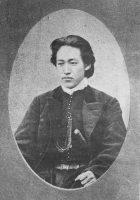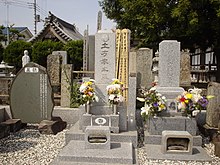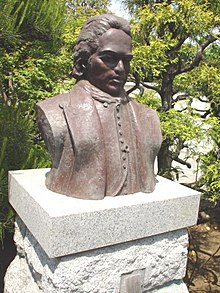| 义豊 | |
| 豊玉 | |
| | |
生涯
出身
武藏国多摩郡石田村(现在东京都日野市石田)出生。一般认为他是六兄弟姐妹中最小的,近年的史料发现可能实为十兄弟姐妹中最小的。土方家出身为平民。出生前父亲已过世,六岁时母亲亦过世,而由二哥喜六夫妻俩扶养长大。
十一岁时在江户上野的“松坂屋和服店”(现在松坂屋上野店)当学徒,但不久即因和前辈争执而返回日野。十七岁时至江户传马町的和服店工作,亦因为和上司不和而回到日野。之后以其家相传的秘方伤药“石田散药”四处行商,并在此时至各地的剑道道场修业及比试。在日野的佐藤道场, 通过姐夫佐藤彦五郎结识了之后的天然理心流第四代传人岛崎胜太(之后的新选组局长近藤勇)。岁三在安政六年(1859年)3月29日、正式成为天然理心流的入门弟子。文久3年2月,岁三随着近藤道馆的师兄弟一起参加幕府上京都的浪士组召募。
新选组副长
文久3年(1863年)八月十八日政变后,他与近藤勇所参加的壬生浪士组因功赐名为新选组。近藤勇原本与芹泽鸭、新见锦共同领导,但芹泽与新见二人在京都经常酒醉闹事,甚至勒索,后新见锦切腹、近藤派并肃正了芹泽和其党羽、自此近藤勇终于得以一伸报国之志,而土方则就任副长,负责京都的治安警护维持。
新选组的权力集中在局长,出谋划策则由副长土方承担。元治元年(1864年)6月5日池田屋事件时、土方率队前往长州土佐藩士进出频繁的四国屋进行搜索,却不见可疑人物,旋即前往池田屋支援近藤等人。新选组在池田屋事件之后得到破格的恩赏。
新选组的局中法度,对违法犯纪和无故叛逃的队士相当严格,往往切腹是唯一的惩罚。连总长山南敬助叛逃之举,也被下令切腹。
戊辰战争
庆应3年(1867年)6月他被封为幕臣,但同年10月14日即发生大政奉还、12月9日王政复古时事实上幕府已经瓦解。庆应4年1月3日,以鸟羽伏见之战为前哨的戊辰战争爆发,土方代替于墨染事件中负伤的局长近藤勇率领新选组参战,但在皇军新式枪炮前败北。土方觉悟到冷兵器的时代已经过去,而开始致力引进西洋军备。
鸟羽伏见之战战败的幕府军从大坂往江户撤退后,近藤化名大久保刚、土方化名内藤隼人避走甲斐,于3月6日甲州胜沼之战再度败退。4月3日时在皇军包围下,土方阻止了近藤的切腹谢罪,并前往江戸向胜海舟请求赦免近藤,但胜海舟未能成功说服皇军,庆应4年(1868年)4月25日、近藤勇在板桥(现在JR板桥站前)被斩首。
是年4月11日,江户城无血开城。土方率流山残部与幕府军主力会师。之后,土方和立见尚文、秋月登之助于半日内攻破皇军名将有马藤太镇守的宇都宫城(关东七大名城之一,素有难攻不落之名)。但是壬生之战中,土方不幸于乱军中被地面跳弹所伤,转进会津休养了三个月,并在此时兴建了供奉近藤勇的天宁寺。
8月会津战争,土方前往庄内藩寻求援军支援,之后在仙台加入了榎本武扬率领的旧幕府海军继续奋战新政府军。与榎本共同出席奥羽越列藩同盟军议、但奥羽越列藩同盟不久即瓦解、同盟藩一一向皇军屈服投降,遂率领新选组残部和桑名藩士乘上大江号、与榎本武扬于10月12日自仙台折滨(现宫城县石卷市折滨)出航、前往虾夷地(北海道)。
箱馆战争
10月20日、于虾夷地鹫之木上陆后、土方被任为兼道军总督攻向五棱郭城。箱馆(今函馆市)・五棱郭占领后、土方率领额兵队直扑松前城(福山城),未几应声陷落。同时、榎本武扬率领海军掩护、但开阳号军舰却在江差冲遇上暴风雨而触礁沉没。12月15日榎本为招待各国领事返回五棱郭,并举办亚洲第一次记名选举。开票结果,由通晓国际公法的榎本武扬担任总裁,并公告列强,成立虾夷共和国继续对抗新政府军。土方就任陆军奉行并(陆军副司令,中将缺)、兼箱馆市中取缔(警察总长)及陆海军裁判局长(陆海军宪兵总监)。
先有近代东洋海战史首见之接舷作战,也就是著名的宫古湾海战,土方以回天一舰突入新政府军泊地,强袭官军旗舰甲铁,但因甲铁拥有新兵器格林机枪而不幸功败垂成。
明治2年(1869年)6月20日(阴历5月11日)、新政府军箱馆战争总攻击开始、新选组队士岛田魁守备的辩天台场被新政府军包围,陷入孤立。土方率领少数士兵突围相救。土方一夫当关,力阻自七重滨大举进犯的新政府军于一本木关口,却不幸在乱战之中腹部中弹,落马不治。不久榎本武扬开城投降,虾夷共和国灭亡,土方的遗体下落不明,而其他战死者则被埋葬在五棱郭内。
其他
土方岁三与新选组的故事成为日本大众文化脍炙人口的一环,在往后的小说和电影、动漫中都有不少以他为题材。在日本更有不少土方迷成立的社团。
墓地(纪念碑)
其佩刀为打刀“和泉守兼定”(いずみのかみかねさだ)和胁差“堀川国广”(ほりかわくにひろ)。
其兴趣另有和歌与俳句,展现其风雅的一面,著有《丰玉发句集》。
由于土方岁三流传后世的照片与漫画家荒木飞吕彦十分相似,且荒木驻颜有术的情况,让杂志“ダ・ヴィンチ”在其2012年8月号特集中,以半开玩笑的方式将土方的照片作为他1868年时的样貌。
登场作品
- 小说
- 新选组始末记(角川书店、子母泽宽著)
- 新选组血风录(中央公论新社、司马辽太郎著)
- 燃剑(文艺春秋、司马辽太郎著)
- 幕末新选组(文艺春秋、池波正太郎著)
- 壬生义士传(文艺春秋、浅田次郎著)
- 虎狼的天空 小说新选组(文艺春秋、津本阳著)
- 最后的武士道(集英社、津本阳著)
- 土方歳三-壬生狼(德间书店、峰隆一郎著)
- 新选组斩人剑―小说・土方歳三(讲谈社、早乙女贡著)
- 回天之梦―小说土方岁三(角川学艺出版、井上进著)
- 不恭顺的官贼 新撰组土方歳三的生存之方(KADOKAWA、原田伊织著)
- 草莽枯行(集英社、北方谦三著)
- 黑龙之柩(幻冬舍、北方谦三著)
- 最终的决斗者(中央公论新社、逢坂刚著)
- 岁三之剑(讲谈社、小松エメル著)
- 土方岁三(角川书店、富㭴伦太郎著)
- 松前之花-土方岁三 虾夷血风录(中央公论新社、富㭴伦太郎著)
- 土方岁三:为剑而生 为诚而殉的生涯(PHP研究所、松永义弘著)
- 明治维新 血的最前战-土方岁三 与长州战至最后的男人(樱花舍、星亮一著)
- 土方岁三的生涯(新人物往来社、菊地明著)
- 土方歳三的鬼谋(角川春树事务所、柘植久庆著)
- 土方岁三(学研、岳真也著)
- 北辰挽歌―土方岁三 海战(学研、辻真先著)
- 战士之赋-土方岁三的生与死(集英社、三好彻著)
- 散华 土方岁三(新人物往来社、萩尾农著)
- 新选组 幕末青岚(集英社、木内昇著)
- 新选组意外史(作品社、八切止夫著)
- 来自岁三的传言(讲谈社、北原亚以子著)
- 土方歳三(新人物往来社、大内美予子著)
- ヒトごろし(新潮社、京极夏彦著)
- 幕末群像传 土方岁三(AI出版、小岛政孝著)
- 翱翔苍空 土方歳三战斗选集(牧野出版、横山北斗著)
- 火星的土方岁三(朝日Sonorama、吉冈平著)
- Baragaki 土方岁三青春谱(讲谈社、中场利一著)
- 土方岁三:我拥有的天空(明窗出版、七滨凪著)
- 土方岁三无赖控-Baragaki・参上(文艺社、潮美瑶著)
- 影视剧
- 维新之曲(1942年、大映、演:寺岛贡)
- 新撰组(1952年、东映、演:河津清三郎)
- 近藤勇 池田屋骚动(1953年、新东宝、演:阿部九州男)
- 新选组鬼队长(1954年、东映、演:原健策)
- 桂小五郎与近藤勇:龙虎决战(1957年、新东宝、演:江川宇礼雄)
- 新选组(1958年、东映、演:山形勋)
- 壮烈新选组 幕末动乱(1960年、东映、演:黑川弥太郎)
- 剑豪秘传(1960年、NET、演:原保美)
- 新选组始末记(1961年、TBS、演:户浦六宏)
- 新选组血风录 近藤勇(1963年、东映、演:加藤武)
- 新选组始末记(1963年、大映、演:天知茂)
- 幕末残酷物语(1964年、东映、演:西村晃)
- 风云儿半次郎(1964年、MBS、演:佐藤庆)
- 新选组血风录(1965年、NET、演:栗冢旭)
- 燃剑(1966年、TX、演:内田良平)
- 三姊妹(1967年、NHK大河剧、演:岩下浩)
- 第十一位志士(1968年、NET、演:原田芳雄)
- 日本剑客传(1968年、NET、演:寺岛达夫)
- 龙马来了(1968年、NHK大河剧、演:金内吉男)
- 鞍马天狗(1969年、NHK、演:前田昌明)
- 新选组(1969年、东宝、演:小林桂树)
- 剑豪(1970年、NET、演:胜部演之)
- 冲田总司(1974年、东宝、演:高桥幸治)
- 胜海舟(1974年、NHK大河剧、演:藤龙也)
- 鞍马天狗(1974年、NTV、演:成田三树夫)
- 呐喊(1975年、ATG、演:仲代达矢)
- 花神(1977年、NHK大河剧、演:长冢京三)
- 新选组始末记(1977年、TBS、演:古谷一行)
- 幕末未来人(1977年、NHK、演:青砥洋)
- 鞍马天狗(1981年、TBS、演:细川俊之)
- 宛如炎光(1981年、东宝、演:伊吹吾郎)
- 冲田总司 华丽的暗杀者(1982年、CX、演:柴俊夫)
- 龙马来了(1982年、TX、演:伊达正三郎)
- 壬生恋歌(1983年、NHK、演:夏八木勋)
- 燃花迸散:炎之剑士 冲田总司(1984年、NTV、演:柴田恭兵)
- 白虎队(1986年、NTV、演:近藤正臣)
- 高尔夫黎明之前(1987年、东宝、演:西川纪夫)
- 新选组(1987年、ANB、演:竹胁无我)
- 五棱郭(1988年、NTV、演:渡哲也)
- 野心之国(1989年、NTV、演:本田博太郎)
- 鞍马天狗(1990年、TX、演:菅田俊)
- 燃剑(1990年、TX、演:役所广司)
- 幕末纯情传(1991年、松竹、演:杉本哲太)
- 新选组:池田屋血斗(1992年、TBS、演:地井武男)
- 太阳照常升起(1996年、CX、演:渡边裕之)
- 新选组血风录(1998年、ANB、演:村上弘明)
- 德川庆喜(1998年、NHK大河剧、演:桥爪淳)
- 尾张幕末风云录(1998年、TX、演:北爪俊行)
- 御法度(1999年、松竹、演:北野武)
- 壬生义士传 新选组最强的男人(2002年、TX、演:伊原刚志)
- 壬生义士传(2003年、松竹、演:野村祐人)
- IZO(2004年、Teamokuyama、演:胜野洋)
- 新选组!(2004年、NHK大河剧、演:山本耕史)
- 轮违屋糸里〜女子们的新选组〜(2007年、TBS、演:伊藤英明)
- 龙马传(2010年、NHK大河剧、演:松田悟志)
- 新选组血风录(2011年、NHK-BS、演:永井大)
- 白虎队:不败的人们(2013年、TX、演:岸谷五朗)
- 八重之樱(2013年、NHK大河剧、演:村上淳)
- 燃剑(2020年、东宝、演:冈田准一)
- 动漫画
- 银魂(集英社、空知英秋作)
- 琥珀ACE(角川书店、经验值作)
- 茜色之风:新撰组血风记录(集英社、车田正美作)
- 爆弹!〜幕末男子〜(讲谈社、加濑敦作)
- 陆奥圆明流外传 修罗之刻 风云幕末编(讲谈社、川原正敏作)
- 风光(小学馆、渡边多惠子作)
- 月明星稀:再会新选组(小学馆、盛田贤司作)
- PEACE MAKER铁(艾尼克斯、黑乃奈奈绘作)
- 新选组刃义抄:ASAGI(艾尼克斯、山村龙也作・蜷川八重子画)
- 北走新选组(白泉社、菅野文作)
- Chiruran:新撰组镇魂歌(Coamix、梅村真也作・桥本英治画)
- 错过星星的男人(青林堂、水木茂作)
- 猫猫新撰组(德间书店、耳式作)
- 歳三〜新撰组箱馆战记〜(潮出版社、神田贵志作)
- 漂流武士(少年画报社、平野耕太作)
- 黄金神威(集英社、野田智作)
- 天漫浮世录 (小学馆、赤堀悟作・北崎拓画)
- 北之边境的梦 土方岁三外传(Beaglee、佐知美梨穗作)
- 薄樱鬼 ~新选组奇谭~
- 刀剑乱舞
- 游戏
- Fate/Grand Order(配音:星野贵纪)
- 在茜色世界与君咏唱(配音:津田健次郎)
参见
参考文献
Hijikata Toshizō (土方 歳三, May 31, 1835 – June 20, 1869) was a Japanese warrior. As Vice-Commander (副長, Fukucho) of the Shinsengumi, he resisted the Meiji Restoration.
Background
Hijikata Toshizō Yoshitoyo (土方 歳三 義豊) was born on May 31, 1835, in the Ishida village, Tama region of Musashi Province (present day Ishida, Hino), Japan. He was the youngest of six children (later records discovered in recent years revealed that he was actually the youngest among the ten children), and his father Hijikata Yoshiatsu (Hayato), a well-to-do farmer, died a few months before his birth. His eldest brother Tamejiro, was born blind and as a result, could not inherit the family property. His 3rd older brother Daisaku (later Kasuya Ryojin), was adopted to another family and would later become a physician. His eldest sister Shuu died when he was about three years old and his mother Etsu also died when he was six years old, and he was therefore raised by his 2nd older brother Kiroku and sister-in-law.
He was apparently tall compared to the average Japanese men of the period, and it is said that he was very handsome. He was said to be spoiled at an early age and was alleged to be mean to all but his friends and family. This changed when a 21-year-old swordsman from the Aizu clan known for opposing the Reformists was forced to commit seppuku. When Hijikata attended the man's funeral, he apparently cried in public.
Hijikata spent his youth selling his family's Ishida sanyaku (medicine for treating injuries such as bruises and broken bones) while practicing his self-taught kenjutsu. His brother-in-law, Satō Hikogorō, who was married to his older sister Nobu, managed a Tennen Rishin-ryū dojo in Hino; through Satō, Hijikata later met Kondō Isami and was formally enrolled at the Tennen Rishin-ryū's Shieikan in 1859. Although Hijikata himself never fully mastered the Tennen Rishin-ryū, it is said that he managed to develop the "Shinsengumi-Kenjutsu" fighting style from the Tennen Rishin-ryū.
An arrangement was made by his eldest brother Tamejiro for him to marry Okoto, the daughter of the shamisen shop owners. Since he had already planned to join the Rōshigumi with Kondō Isami, Hijikata told them that after he got a promotion, he would carry out his marriage.
Shinsengumi period
However, Serizawa and Niimi began fighting, drinking, and extorting money from merchants in Kyoto, which started to tarnish the reputation of Shinsengumi and earned the group the derogatory nickname of "Wolves of Mibu" (壬生狼, Miburō). Hijikata found enough proof against Niimi in these matters and ordered him to commit seppuku on October 19. Later on October 30 (or October 28) at night, Hijikata and the selected Shinsengumi members went into the house of Yagi Gennojō and assassinated Serizawa, his mistress Oume, and one of his followers Hirayama Goro, with Hirama Jūsuke been the only survivor fled that night. Kondō became the sole leader of Shinsengumi, with Yamanami Keisuke as his Vice-Commander.In 1863, Hijikata and Kondō Isami joined the Rōshigumi in Edo, they arrived in Mibu, Kyoto and remained there as the Mibu Rōshigumi while the rest returned to Edo. Later, when Mibu Rōshigumi was renamed as the Shinsengumi, Kondō and two other men, Serizawa Kamo and Niimi Nishiki, became joint leaders of the group, and Hijikata served as one of the deputy leaders. Shinsengumi served as a special police force in Kyoto that fought against the Reformists under Matsudaira Katamori, the Daimyō of Aizu.
Some time after the Zenzaiya incident, Yamanami Keisuke tried to leave Shinsengumi, despite the regulation against deserters. As a result, he committed seppuku with Okita Sōji as his Kaishakunin on March 20 (lunar calendar February 23), 1865; and Hijikata took over as Vice-Commander. Due to his position in the Shinsengumi, which would be dangerous for anyone close to him, Hijikata felt that he had no choice but to cancel his marriage engagement with Okoto. Although he later had many lovers, he never came close to making a commitment to any of them.
The Shinsengumi grew to 140 men, which included a number of farmers and merchants whose livelihood would be threatened if the Tokugawa shogunate was overthrown. The regulations set up by Shinsengumi within Kyoto were strict and Hijikata was known to be harsh in enforcing them, hence his nickname: "Demon Vice-Commander" (鬼の副長, Oni no fukucho). Even within the Shinsengumi itself, regulations were strictly enforced by Hijikata. As usual, deserters and traitors were forced to commit seppuku.
Hijikata owned, among others, a sword signed "Izumi no Kami Kanesada" (和泉守兼定), made by the 11th and last generation[clarification needed] Aizu Kanesada (1837-1903).
Together with the rest of the Shinsengumi, Hijikata became a hatamoto in 1867 and took the name of Naitō Hayato (but reverted to his original name after Kondō was captured and executed during the Boshin war). He was given the rank of Yoriai (寄合格 Yoriai-kaku) in early 1868.
Boshin War
On March 29, 1868, Kondō, Hijikata and the Kōyō Chinbutai resisted an attack by the Imperial forces at the Battle of Kōshū-Katsunuma for about two hours but lost, and they were scattered and fled to Edo.Following the Boshin War in 1868, Kondō and Hijikata led the Shinsengumi in their final battles against the new government and fought in the Battle of Toba–Fushimi in January 1868. The Shinsengumi returned to Edo and was later reformed into a unit known as the Kōyō Chinbutai (甲陽鎮撫隊, "Pacification Corps") and departed from Edo for Kōfu Castle on March 24 upon orders to suppress the uprisings there. But while on the way there, they received news on March 28 that the Kōfu Castle was taken by Imperial Court forces led by Itagaki Taisuke and later settled at a town of Katsunuma five miles east of Kōfu.
On April 11, 1868, Kondō, Hijikata and the Kōyō Chinbutai departed Edo again and later set up a temporary headquarters at the Kaneko family estate, northeast of Edo. They later moved to a new headquarters in Nagareyama on April 25, 1868.
During the training at Nagareyama on April 26, 1868, the Kōyō Chinbutai were caught by surprise by the 200 strong Imperial forces led by Vice-chief of Staff Arima Tota of Satsuma Domain and Kondō was ordered to go with them to their camp at Koshigaya. He was later brought to Itabashi on April 27, 1868, for questioning. On the same day Hijikata went to Edo to see Katsu Kaishū and asked for his help in getting a pardon for Kondō. On the following day, a messenger arrived at Itabashi with a letter seemingly written by Katsu requesting that Kondō's life to be spared, but the messenger was arrested and the request was denied.
Following his trial on April 31, 1868, Kondō was executed at Itabashi execution grounds on May 17, 1868. Hijikata, convalesced from a foot injury sustained at the Battle of Utsunomiya Castle, brought Kondō's hair to Aizu and was said to have personally supervised the erection of Kondō's grave memorial at Tenneiji Temple.
Following the Battle of Bonari Pass, the next day on October 7, 1868, Hijikata met Saitō Hajime at the Inawashiro Castle and stayed at the Saitoya inn in Wakamatsu. When Hijikata decided to retreat from Aizu, Saitō and a small group of Shinsengumi parted with Hijikata and continued to battle in the Battle of Aizu until the very end. Hijikata and his rest of the Shinsengumi went to Sendai, where he joined up with Enomoto Takeaki's fleet.
He knew he was fighting a losing battle, and told the physician Matsumoto Ryōjun:
In October 1868, Hijikata and Ōtori Keisuke led Shogunate forces to occupy the fortress of Goryōkaku in the Battle of Hakodate, and continued to eliminate local resistance. When the short-lived Ezo Republic was founded in December, Hijikata was made a Deputy Defence Minister (Vice-minister of the Army). Imperial troops continued to attack by land and sea.
On May 6, 1869, Hijikata led a daring but doomed raid to steal the imperial warship Kōtetsu in the Battle of Miyako Bay, in the early morning, a number of oppositionists managed to board the ship via the Kaiten warship, but Kōtetsu repelled the attack and mowed them down with a Gatling gun. Many others including the captain of Kaiten were also killed by gunfire from the Imperial ships. The battle lasted only thirty minutes; Hijikata, the survivors and the Kaiten retreated to Hakodate.
Later on the fourth week of May 1869, Hijikata led the 230-strong Republic of Ezo forces and the surviving Shinsengumi against 600 strong Imperial forces during the Battle of Futamata for sixteen hours and were forced to retreat. The Imperial forces attacked again on the next day, only to retreat. On the following night, Hijikata led a successful raid on the Imperial forces' camp, forcing them to flee. Hijikata and the forces later retreated to Hakodate on June 10.
Death
During the Battle of Hakodate, the final battle of the Boshin War, Hijikata summoned his 16-year-old page, Ichimura Tetsunosuke on June 14 (lunar calendar May 5), 1869, to a private room in an inn. There, he entrusted Ichimura with a death poem, his katana, a letter, a photograph of himself, and several strands of his hair. Ichimura was instructed to bear them to the home of Hijikata's brother-in-law Satō Hikogorō in Hino. The death poem entrusted to Ichimura reads:
In the final conflict of the revolution, on June 20 (lunar calendar May 11), 1869, Hijikata was killed near the Ippongi Kanmon (一本木関門) while leading his troops on horseback by a bullet that shattered his lower back. His body was later claimed by Koshiba Chōnosuke and others.
Three days later on June 23 (lunar calendar May 14), 1869, a remaining group of surviving Shinsengumi members under the last commander Sōma Kazue had surrendered at Benten Daiba. A week after his death, the Goryōkaku fortress was taken, and the military of Ezo Republic surrendered to the Meiji government on June 27, 1869, marked the end of Boshin War.
It is unknown where Hijikata was buried, but it is believed that his body was buried either at Goryōkaku, Hekketsuhi or Ganjoji.
Grave memorials and monuments
The first grave memorial of Hijikata was at Wakamatsu-chō, Hakodate, where he was killed, near the reconstructed Ippongi Kanmon in the present day compound of the Hakodate Welfare Centre.
A grave memorial of Hijikata was also erected at Sekidenji temple in Hino, Tokyo, Japan.
Other grave memorials were located at Shōmyōji (Hakodate, Hokkaido), Tenneji (Aizuwakamatsu), Jutokuji (Kita, Tokyo), Entsūji (Kita, Tokyo), etc.
A monument known as Hekketsuhi, was erected at Hakodate in memory of about 800 people, including Hijikata, who died during the Boshin War.
In 1875, Nagakura Shinpachi, with the help of Matsumoto Ryōjun and several of his surviving former Shinsengumi comrades including Saitō Hajime among others, erected the monument known as the Grave of Shinsengumi for Kondō Isami, Hijikata Toshizō, and the fallen comrades of the Shinsengumi at Jutoku-ji temple boundary in Itabashi, near Itabashi Station in Tokyo.
The Hijikata Toshizō Museum was later established in 1994 near the Sekidenji temple.
In popular culture
The Shinsengumi have become a popular subject for films, television, and manga and anime, ranging from historical drama to comedy and romance. As a leader of the group, Hijikata is usually a prominent character in such productions.
The novel Moeyo Ken, written by Ryōtarō Shiba, is a dramatization of Hijikata's life. The novel was adapted into a film in 1966 and a television series in 1970 where Hijikata was played by Asahi Kurizuka.
Hijikata is depicted in the 1999 film Gohatto ("Taboo") (played by Takeshi Kitano) and the 2013 NHK Taiga drama Yae no Sakura (played by Jun Murakami). He was also played by Koji Yamamoto in both the 2004 NHK Taiga drama series Shinsengumi! (including the single-episode sequel Shinsengumi!: Hijikata Toshizo Saigo no Ichinichi) and 2015 Taiga drama series Asa ga Kita. He is the protagonist in Morita Kenji's manga Getsumei Seiki, and in Mibu Robin's Baragaki ("Red Demon").
He is also featured in a number of other anime and manga series, including Gintama (an inspired character named Hijikata Tōshirō 土方 十四郎), Peacemaker Kurogane, Intrigue in the Bakumatsu - Irohanihoheto, Ghost Slayers Ayashi (as a child, with a brief glimpse of his future death); Kaze Hikaru, Shura no Toki, Hell Girl, Soar High! Isami (inspired character: Toshi Tsukikage) and the popular otome game/anime series Hakuouki: Shinsengumi Kitan. Hijikata is also a supporting character in Shin Teito Monogatari, the prequel to the bestselling historical fantasy novel Teito Monogatari (Hiroshi Aramata). In the manga and anime, Drifters, Hijikata serves as one of the antagonists, who holds hatred to the protagonist, Shimazu Toyohisa, because he is an ancestor of the Shimazu clan he fought. He is also a main character in the manga Golden Kamuy, having been secretly imprisoned in Abashiri Prison instead of killed. Hijikata appears in the 2014 historical fiction novel The Soldier and the Samurai.(ISBN 1500183059)
Hijikata is one of the main characters in the 2014 video game Ryū ga Gotoku Ishin!, voiced by Nakamura Shidō II.
Hijikata also appears in the mobile game Fate/Grand Order as a limited 5-Star Berserker-class Servant. He debuted during the GUDAGUDA 2: Meiji Restoration event, and his Noble Phantasm is known as Shinsengumi, which gets stronger as his HP dwindles.
Notes
- ^ 幕臣取り立て 新選組概史 歴史館-動乱の章 Archived 2013-08-16 at the Wayback Machine; accessed 16 June 2015.
- ^ a b c 土方歳三 HIJIKATA, tamahito.com; accessed 16 June 2015.
- ^ Lee, Rosa (January 2011). "Romanticising Shinsengumi in Contemporary Japan". New Voices in Japanese Studies. 4: 168–187.
Further reading
- Hijikata Toshizō and Okita Sōji. Hijikata Toshizō, Okita Sōji zenshokanshū edited by Kikuchi Akira. Tōkyō : Shin Jinbutsu Ōraisha, 1995. ISBN 4-404-02306-5.
- Itō Seirō. Hijikata Toshizō no nikki. Tokyo: Shin Jinbutsu Ōraisha, 2000. ISBN 4-404-02861-X
- Kikuchi Akira, et al. Shashinshū Hijikata Toshizō no shōgai. Tōkyō : Shin Jinbutsu Ōraisha, 2001. ISBN 4-404-02930-6
- Miyoshi Tōru. Senshi no fu: Hijikata Toshizō no sei to shi. Tōkyō: Shueisha, 1993. ISBN 4-08-748001-1 ISBN 408748002X.
- Tanaka Mariko and Matsumoto Naoko. Hijikata Toshizō Boshin senki. Tōkyō : Shin Jinbutsu Ōraisha, 1976.
- "Moe Yo Ken" ('Burn, My Sword') by Shiba Ryoutarou (http://moeyoken.blogspot.com/2009/01/1.html) Entire fictional biography of Toshizo (link no longer active)
- Hillsborough, Romulus. Shinsengumi: The Shōgun's Last Samurai Corps. North Clarendon, Vermont: Tuttle Publishing, 2005. ISBN 0-8048-3627-2.
External links
- Hino city museum (in Japanese)
- Hijikata Toshizo Archives (in Japanese)
- SamuraiWiki






